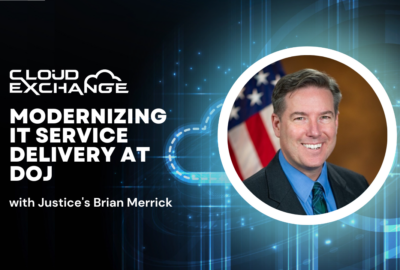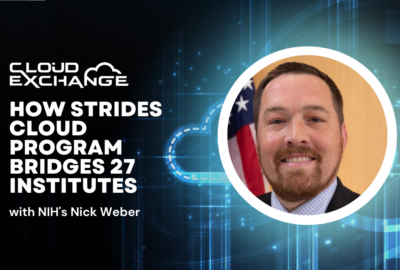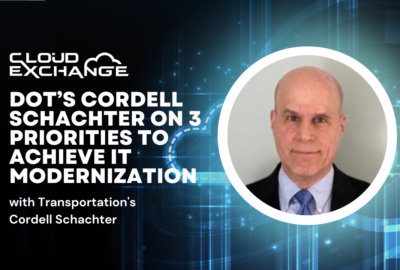Insight by IBM
Cloud Exchange 2023: IBM’s Mark Johnson, Leon Platts on HPC driving health care breakthroughs
By combining cloud, high-performance computing and artificial intelligence, IBM and Cleveland Clinic create a model for achieving health care breakthroughs. Lea...
Federal health care agencies are working alongside industry partners to develop new approaches to service delivery and also medical research.
Agencies are delivering on their mission by using automation, cloud and high-performance computing (HPC) tools to unlock new insights from their data, said Mark Johnson, vice president of federal technology at IBM.
“Cloud is a way to put our arms around that data. But to really discover new things and to be able to apply those to health outcomes, it takes machine learning and artificial intelligence,” Johnson said. “Only the computers and the capability of high-performance computers are able to go through all that and find what matters.”
We spoke to Johnson, along with IBM HPC cloud expert Leon Platts and leaders of a forward-thinking partnership between IBM and Cleveland Clinic, during the Federal News Network Cloud Exchange 2023. They shared insights about how HPC paired with cloud is evolving and what’s possible next.
For example, right now, the Department of Veterans Affairs is relying on these tools to tackle addiction and mental health issues among veterans, Johnson said. And the Department of Health and Human Services is also using AI/ML to reach new breakthroughs in personalized health care.
Modern HPC systems run more than a million times faster than the desktops and laptops used in most households and businesses and are accelerating the pace of medical breakthroughs, Platts said.
High-performance computing is leading to new discoveries in the development of pharmaceutical drugs, cancer diagnoses and molecular modeling, he added.
Platts noted that the first attempt to sequence the human genome took about 13 years, but the latest HPC systems could handle the same task in less than a day.
“I think we’ll see the likes of HPC really infiltrating all segments of government, because as we get more data, we’ve got to do more with it. And these kinds of technologies really enable us to take that data, find the patterns and determine what that data is telling us and make really smart decisions,” he said.
These technologies are also transforming the medical research efforts outside the federal government through partnerships like the one IBM has with Cleveland Clinic.
IBM partnership with Cleveland Clinic
In March 2021, Cleveland Clinic and IBM announced a 10-year partnership to establish the Discovery Accelerator using IBM Quantum System One.
Ahmet Erdemir, chief scientist for the Cleveland Clinic – IBM Discovery Accelerator, said researchers are relying on the HPC project to advance the pace of scientific discoveries.
“This is really about the intersecting, cutting-edge biomedical research, the constraints and the desire to deliver health care equitably and quickly, and how we can actually intersect that with advancements in computing technologies and computer science,” Erdemir said.
John Smith, an IBM fellow with the Discovery Technology Foundations, Accelerated Discovery at IBM Research, said a hybrid cloud environment gives researchers an opportunity to access disparate data sets and then use HPC to unlock new insights from the data.
“Given all our challenges, we need to greatly increase the pace of scientific discovery. We need to be even more efficient and effective at exploiting data and knowledge and computation in clever ways. In short, we need to overcome the bottlenecks in discovery, and that’s where AI, hybrid cloud and quantum computing come in,” Smith said.
Researchers, he added, can spend up to a decade and about $1 billion on R&D to develop the next big pharmaceutical drug. But high-performance computing may be able accelerate that timeline.
“Each new drug is like finding a golden needle in an enormous haystack. So, we’re investigating how to use quantum computing in this space for drug discovery as well as AI,” Smith said.
AI tools allow researchers to make more accurate predictions, reduce the cost of expensive simulations, and generate new ideas and hypotheses, he and Erdemir said.
Medical researchers are also using AI to produce 3D and 4D models to better predict the properties of molecules within biological systems.
A new generation of HPC is on the horizon. Smith called the emergence of quantum computing a game changer in terms of providing exponentially faster computation power.
“Ultimately, these computing technologies can allow us to go faster, reduce cost and create new and urgently needed solutions to problems,” he said.
In March of this year, IBM and the Cleveland Clinic announced the installation of IBM Quantum System One at Cleveland Clinic’s main campus.
Erdemir said the quantum resources are the first of their kind dedicated to health care research and are giving researchers tools to take on new workloads where AI has fallen short.
“We have a pipeline where we are bringing investigators together,” he said. “We are identifying our data challenges.”
The Cleveland Clinic – IBM Discovery Accelerator captures an ecosystem, making AI, high-performance computing and quantum computing, all available to health care research teams, Erdemir said. IBM Quantum System One also gives computer scientists and medical researchers an opportunity to brainstorm on new use cases.
“If you’re sitting next to the quantum computer, which is essentially in the middle of our cafeteria … with computer scientists, with a biomedical researcher, with a clinician discussing a project next to it, and immediately being able to start executing simulations is very inspirational, and I think it opens up a lot of opportunities for us,” Erdemir said.
HPC beyond health care
Beyond health care, agencies are looking to leverage more insights from the data they already have.
Johnson said the Environmental Protection Agency, for instance, is using these tools to study and prevent train derailments.
“High-performance computing brings those kinds of solutions to AI — being able to train the models, to be able to watch for bias, being able to predict where things are coming from, being able to handle the massive amounts of data that each of these have and apply that to machine learning,” Johnson said.
The Defense Department is also using HPC and AI tools to better understand what’s happening at the edge of its network and make time-sensitive decisions more quickly.
“It’s up to industry really to work with the federal government to bring [together] all these disparate technologies,” Johnson said. “Some are just emerging. We’re talking about AI and generative AI, and people are just starting to envision what can be done with those.”
To read or watch other sessions on demand, including the one featuring IBM’s John Smith and Cleveland Clinic’s Ahmet Erdemir, go to our 2023 Cloud Exchange event page.
Copyright © 2024 Federal News Network. All rights reserved. This website is not intended for users located within the European Economic Area.
Related Stories
Cloud Exchange 2023: NIH’s Nick Weber explains how STRIDES cloud program bridges 27 institutes
Cloud Exchange 2023: DoT’s Cordell Schachter on 3 priorities to achieve IT modernization
Featured speakers
-

Mark Johnson
Vice President, Federal Technology, IBM
-

Leon Platts
Vice President, Cloud HPC
-

Jory Heckman
Reporter, Federal News Network
Upcoming Events
Related Stories
Top Stories

Mark Johnson
Vice President, Federal Technology, IBM

Leon Platts
Vice President, Cloud HPC

Jory Heckman
Reporter, Federal News Network
Jory Heckman has been a reporter at Federal News Network since January 2018. Jory got his start as an intern in 2011 and was a digital news writer and editor for Federal News Network from 2014 to 2018. He also worked as a desk assistant with CBS News Radio in New York and was a reporter for the Citizens’ Voice newspaper in Wilkes-Barre, Pennsylvania.






